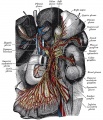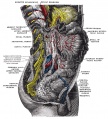Neural Crest - Enteric Nervous System
| Embryology - 16 Apr 2024 |
|---|
| Google Translate - select your language from the list shown below (this will open a new external page) |
|
العربية | català | 中文 | 中國傳統的 | français | Deutsche | עִברִית | हिंदी | bahasa Indonesia | italiano | 日本語 | 한국어 | မြန်မာ | Pilipino | Polskie | português | ਪੰਜਾਬੀ ਦੇ | Română | русский | Español | Swahili | Svensk | ไทย | Türkçe | اردو | ייִדיש | Tiếng Việt These external translations are automated and may not be accurate. (More? About Translations) |
Introduction
The neural crest are bilaterally paired strips of cells arising in the ectoderm at the margins of the neural tube. These cells migrate to many different locations and differentiate into many cell types within the embryo. This means that many different systems (neural, skin, teeth, head, face, heart, adrenal glands, gastrointestinal tract) will also have a contribution fron the neural crest cells.
The enteric nervous system (ENS) regulates many key aspects of the gastrointestinal tract including: motility, secretion and blood flow. In the body region, neural crest cells form the entire enteric nervous system, both neurons and glia, of the gastrointestinal tract.
Neural crest cells initially migrate into the foregut splanchnic mesoderm of the developing gastrointestinal tract, these cells then migrate caudally along the gut into the midgut. A second population of sacral neural crest cells migrate to the region of the hindgut.
The two gastrointestinal plexuses are located between the longitudinal and circular smooth muscle layers (myenteric plexus, Auerbach's plexus) and in the submucosal layer (submucosal plexus, Meissner's plexus). Interstitial cells of Cajal (ICCs) within the myenteric plexus are pacemaker cells that control peristaltic contraction waves.
| Neural Crest Links: neural crest | Lecture - Early Neural | Lecture - Neural Crest Development | Lecture Movie | Schwann cell | adrenal | melanocyte | peripheral nervous system | enteric nervous system | cornea | cranial nerve neural crest | head | skull | cardiac neural crest | Nicole Le Douarin | Neural Crest Movies | neural crest abnormalities | Category:Neural Crest | |||
|
Intestine Development | Gastrointestinal Tract Development
Some Recent Findings
|
| More recent papers |
|---|
|
This table allows an automated computer search of the external PubMed database using the listed "Search term" text link.
More? References | Discussion Page | Journal Searches | 2019 References | 2020 References Search term: Enteric Nervous System Development
|
Development Overview
This data below is a summary from a study of human enteric ganglia development[5] (ages given are gestational age GA weeks)
- week 7 - rostro-caudal neural crest cell colonization of the gut complete and differentiated into neurons and glia. Interstitial cells of Cajal (ICCs) localized in the ganglion plexus.
- foregut neurons and glia were aggregated into ganglion plexus (myenteric region) not in submucosa.
- hind gut neurons and glia are dispersed within the mesenchyme.
- week 9 - myenteric plexus, longitudinal and circular muscle layers formed along the entire gut.
- week 12 - scattered and individual neurons and glia, and small ganglion plexuses were detected in the foregut and midgut submucosa. Muscularis mucosae formed at the foregut and midgut.
- week 14 - ganglion plexus seen in the hind gut submucosa. Muscularis mucosae formed at the hindgut.
- week 20 - ICCs preferentially localized at the periphery of the plexus.
Mouse Model
Mouse enteric plexus GFP [6]
Neural Crest Migration
Abnormalities
Intestinal Aganglionosis
(intestinal aganglionosis, Hirschsprung's disease, aganglionic colon, megacolon, congenital aganglionic megacolon, congenital megacolon) A condition caused by the lack of enteric nervous system (neural ganglia) in the intestinal tract responsible for gastric motility (peristalsis). In general, its severity is dependent upon the amount of the GIT that lacks intrinsic ganglia, due to developmental lack of neural crest migration into those segments. (More? Neural Crest System - Abnormalities)
Historically, Hirschsprung's disease takes its name from Dr Harald Hirschsprung (1830-1916) a Danish pediatrician (of German extraction). In 1886, he presented at the German Society of Pediatrics conference in Berlin a case of 2 infants who died of complications of bowel obstruction (H. Hirschsprung, Stuhltragheit Neugeborener in Folge von Dilatation und Hypertrophie des Colons, Jhrb f Kinderh 27 (1888), pp. 1-7). Later autopsies identified a dilatation and hypertrophy of large intestine, and the rectum appeared normally narrow. Hirschsprung suggested that the condition was an inborn disease and named it congenital megacolon.
The first indication in newborns is an absence of the first bowel movement, other symptoms include throwing up and intestinal infections. Clinically this is detected by one or more tests (barium enema and x ray, manometry or biopsy) and can currently only be treated by surgery. A temoporary ostomy (Colostomy or Ileostomy) with a stoma is carried out prior to a more permanent pull-through surgery.

|

|
|
| Ostomy - Aganglionic portion removed | Stoma - intestine attached to the abdomen wall | |
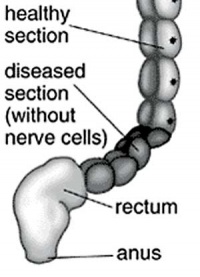
|
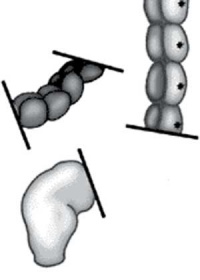
|
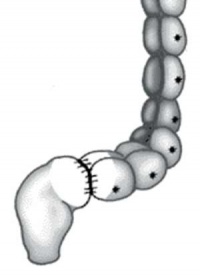
|
| Short section of the colon without smooth muscle neural ganglia | Aganglionic segment removed | Reattachment |
Australian Statistics
Hirschsprung’s disease[7] (1.3 per 10,000 births) ICD-10 Q43.1
- A condition characterised by partial or complete bowel obstruction resulting from absence of peristalsis in a segment of bowel due to an aganglionic section of the bowel.
- More than two-thirds (66.7%) of the babies born with this anomaly were males.
- Women aged 40 years or older had the highest rate of affected pregnancies.
References
- ↑ <pubmed>25519241</pubmed>
- ↑ <pubmed>25535338</pubmed>
- ↑ <pubmed>23167617</pubmed>
- ↑ <pubmed>23229326</pubmed>
- ↑ <pubmed>14991401</pubmed>
- ↑ <pubmed>26943905</pubmed>
- ↑ Abeywardana S & Sullivan EA 2008. Congenital Anomalies in Australia 2002-2003. Birth anomalies series no. 3 Cat. no. PER 41. Sydney: AIHW National Perinatal Statistics Unit.
Reviews
<pubmed></pubmed> <pubmed>22290331</pubmed> <pubmed></pubmed>
Articles
<pubmed></pubmed> <pubmed>23376538</pubmed> <pubmed>23205631</pubmed> <pubmed>22031881</pubmed> <pubmed>17420985</pubmed>
Books
Anderson RB, Newgreen DF, Young HM. Neural Crest and the Development of the Enteric Nervous System. In: Madame Curie Bioscience Database [Internet]. Austin (TX): Landes Bioscience; 2000-. Available from: http://www.ncbi.nlm.nih.gov/books/NBK6273/
Search PubMed
Search Pubmed: Enteric Neural Development | hirschprung's disease
Search All Databases: Enteric Neural Development
Additional Images
External Links
External Links Notice - The dynamic nature of the internet may mean that some of these listed links may no longer function. If the link no longer works search the web with the link text or name. Links to any external commercial sites are provided for information purposes only and should never be considered an endorsement. UNSW Embryology is provided as an educational resource with no clinical information or commercial affiliation.
Glossary Links
- Glossary: A | B | C | D | E | F | G | H | I | J | K | L | M | N | O | P | Q | R | S | T | U | V | W | X | Y | Z | Numbers | Symbols | Term Link
Cite this page: Hill, M.A. (2024, April 16) Embryology Neural Crest - Enteric Nervous System. Retrieved from https://embryology.med.unsw.edu.au/embryology/index.php/Neural_Crest_-_Enteric_Nervous_System
- © Dr Mark Hill 2024, UNSW Embryology ISBN: 978 0 7334 2609 4 - UNSW CRICOS Provider Code No. 00098G





